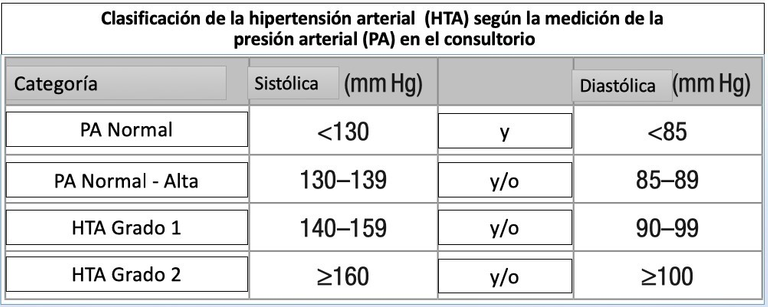[ESP/ENG] Hipertensión arterial sistémica / Systemic arterial hypertension


Hoy les comentaré un poco sobre una patología bastante frecuente y que afecta a una gran parte de la población mundial: hipertensión arterial sistémica.

A cordial greeting to the entire community, a pleasure to greet you, here is your server: @galejandrovv.
Today I will tell you a little about a fairly common pathology that affects a large part of the world's population: systemic arterial hypertension.

¿QUÉ ES LA PRESIÓN ARTERIAL?
¿WHAT IS BLOOD PRESSURE?

Fuente / Source

¿QUÉ ES LA HIPERTENSIÓN ARTERIAL?
¿WHAT IS ARTERIAL HYPERTENSION?

¿CUÁLES SON LOS VALORES NORMALES DE PRESIÓN ARTERIAL?
¿WHAT ARE THE NORMAL BLOOD PRESSURE VALUES?

Fuente / Source

¿QUÉ ES UNA CRISIS HIPERTENSIVA?
¿WHAT IS A HYPERTENSIVE CRISIS?
- Urgencia hipertensiva: sin afectación de órganos/sistemas y se trata de forma ambulatoria, con tratamiento por vía oral.
- Emergencia hipertensiva: hay afectación de algún órgano/sistema y el paciente debe ser hospitalizado para su evaluación, con tratamiento vía endovenosa.
- Hypertensive emergency: without organ/system involvement and is treated on an outpatient basis, with oral treatment.
- Hypertensive emergency: there is involvement of some organ/system and the patient must be hospitalized for evaluation, with intravenous treatment.

¿CUÁLES SON ALGUNOS DE LOS FACTORES DE RIESGO PARA DESARROLLAR HIPERTENSIÓN ARTERIAL?
¿WHAT ARE SOME OF THE RISK FACTORS FOR DEVELOPING HIGH BLOOD HYPERTENSION?
- Sexo masculino.
- Edad avanzada.
- Obesidad.
- Sedentarismo.
- Tabaco.
- Alcohol.
- Antecedentes familiares.
- Estrés.
- Diabetes.
- Male sex.
- Advanced age.
- Obesity.
- Sedentary lifestyle.
- Tobacco.
- Alcohol.
- Family background.
- Stress.
- Diabetes.

CLÍNICA DE UN PACIENTE CON HIPERTENSIÓN ARTERIAL
CLINIC OF A PATIENT WITH ARTERIAL HYPERTENSION
- Cefalea (dolor de cabeza).
- Náuseas.
- Vómitos.
- Sensación de hormigueo en región facial.
- Tinitus (pitidos en los oídos)
- Escotomas centellantes (ver pequeñas luces)
- Dolor ocular.
- Sudoración.
- Headache.
- Nausea.
- Vomiting.
- Tingling sensation in facial region.
- Tinnitus (ringing in the ears)
- Scintillating scotomas (see small lights)
- Eye pain.
- Sweating.

¿CUÁLES SON LOS FÁRMACOS MÁS UTILIZADOS DURANTE EL TRATAMIENTO?
¿WHAT ARE THE MOST USED DRUGS DURING TREATMENT?
- IECAS: captopril, enalapril.
- Antagonistas de canales de calcio: amlodipino, lacidipino.
- Betabloqueantes: carvedilol, atenolol, labetalol, bisoprolol.
- Diuréticos: furosemida, torasemida.
- ARA II: losartán, candesartán, irbesartán.
Estos pueden utilizarse solos o combinados, dependiendo del compromiso del paciente; hay que tener en cuenta que JAMÁS deben combinarse los IECAS con los ARA II, ya que, estos tienen un mecanismo de acción similar y pueden causar disminución rápida de la presión arterial, causando complicaciones severas.
- ACE inhibitors: captopril, enalapril.
- Calcium channel antagonists: amlodipine, lacidipine.
- Beta-blockers: carvedilol, atenolol, labetalol, bisoprolol.
- Diuretics: furosemide, torasemide.
- ARA II: losartan, candesartan, irbesartan.
These can be used alone or in combination, depending on the patient's commitment; It must be taken into account that NEVER ACE inhibitors should be combined with ARBs, since these have a similar mechanism of action and can cause a rapid drop in blood pressure, causing severe complications.

RECOMENDACIONES PARA EVITAR Y/O CONTROLAR EL AUMENTO DE PRESIÓN ARTERIAL
RECOMMENDATIONS TO AVOID AND/OR CONTROL INCREASED BLOOD PRESSURE
- Dieta balanceada.
- Bajo consumo de sal.
- Actividad física.
- Evitar o disminuir el tabaco.
- Evitar o disminuir el consumo de alcohol.
- Evitar el estrés.
- Controlar factores de riesgo.
- Balanced diet.
- Low salt consumption.
- Physical activity.
- Avoid or reduce tobacco.
- Avoid or reduce alcohol consumption.
- Avoid stress.
- Control risk factors.


 |  |  |  |
 |  |  |  |
Texto traducido en XTranslate
Separadores creados en Gravit Designer
Vectores descargados de Flaticon
Banner's creados en Canva
Translated text with the extension XTranslate
Separators created in Gravit Designer
Vectors downloaded from Flaticon
Banner's created in Canva

PRIMUM NON NOCERE

The people doing V2K with remote neural monitoring want me to believe this lady @battleaxe is an operator. She is involved deeply with her group and @fyrstikken . Her discord is Battleaxe#1003. I cant prove she is the one directly doing the V2K and RNM. Doing it requires more than one person at the least. It cant be done alone. She cant prove she is not one of the ones doing it. I was drugged in my home covertly, it ended badly. They have tried to kill me and are still trying to kill me. I bet nobody does anything at all. Ask @battleaxe to prove it. I bet she wont. They want me to believe the V2K and RNM in me is being broadcast from her location. And what the fuck is "HOMELAND SECURITY" doing about this shit? I think stumbling over their own dicks maybe? Just like they did and are doing with the Havana Syndrome https://ecency.com/fyrstikken/@fairandbalanced/i-am-the-only-motherfucker-on-the-internet-pointing-to-a-direct-source-for-voice-to-skull-electronic-terrorism
https://twitter.com/gablejandrovv/status/1500905313674960900
The rewards earned on this comment will go directly to the person sharing the post on Twitter as long as they are registered with @poshtoken. Sign up at https://hiveposh.com.
Congratulations @galejandrovv! You have completed the following achievement on the Hive blockchain and have been rewarded with new badge(s):
Your next target is to reach 40 posts.
You can view your badges on your board and compare yourself to others in the Ranking
If you no longer want to receive notifications, reply to this comment with the word
STOPTo support your work, I also upvoted your post!
Check out the last post from @hivebuzz:
Support the HiveBuzz project. Vote for our proposal!
Gracias @galejandrovv por la información. La verdad es que hay que cuidarse y estar atentos con ciertas señales, sin embargo, he visto personas que se obsesionan y quieren tomarse la tensión cada rato me parece que eso crea mayor estrés.
Saludos.
Siempre a la orden.
Sí, eso que mencionas es un tipo de TOC (Trastorno Obsesivo-Compulsivo), y eso al generar estrés, aumenta la presión arterial; por lo tanto, son personas que mentalmente e enferman y físicamente están normal.